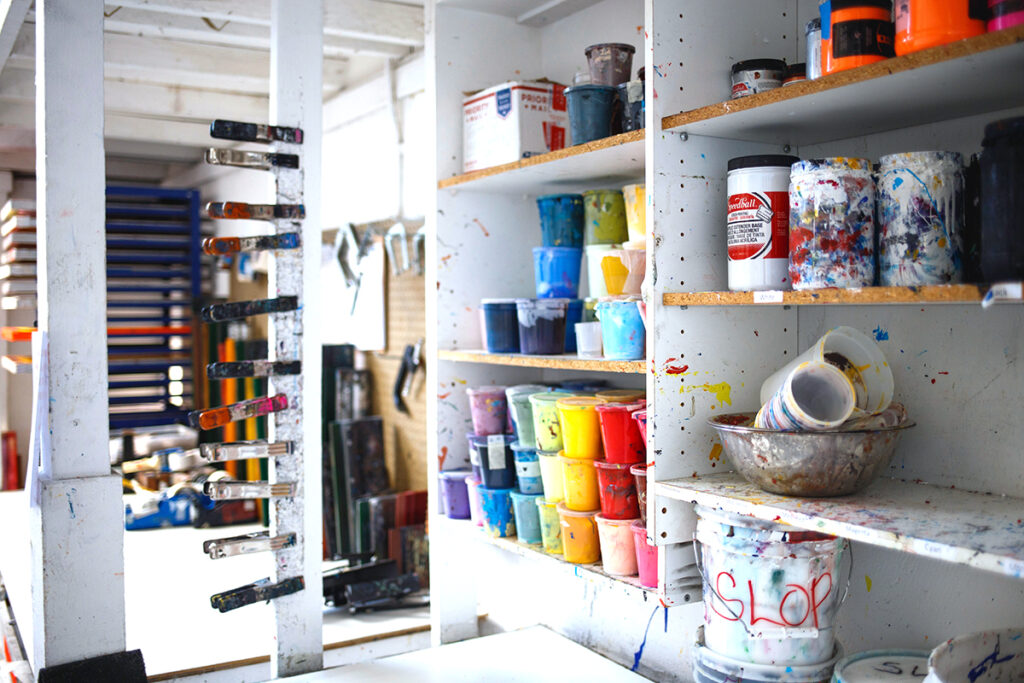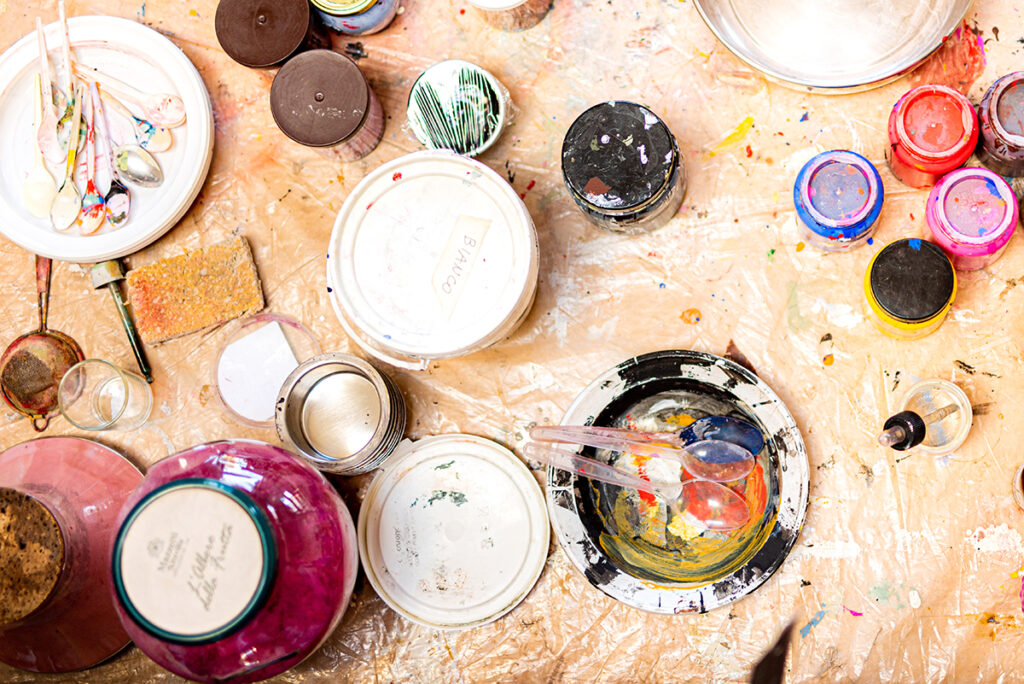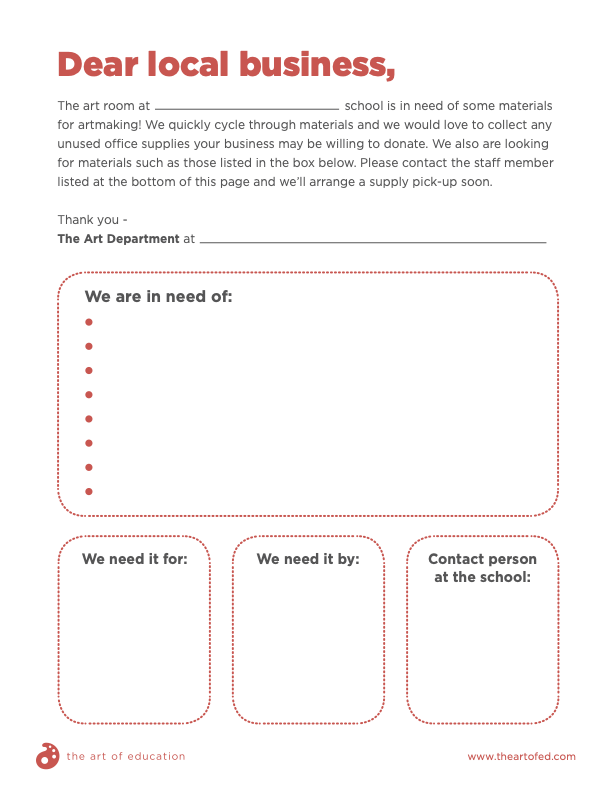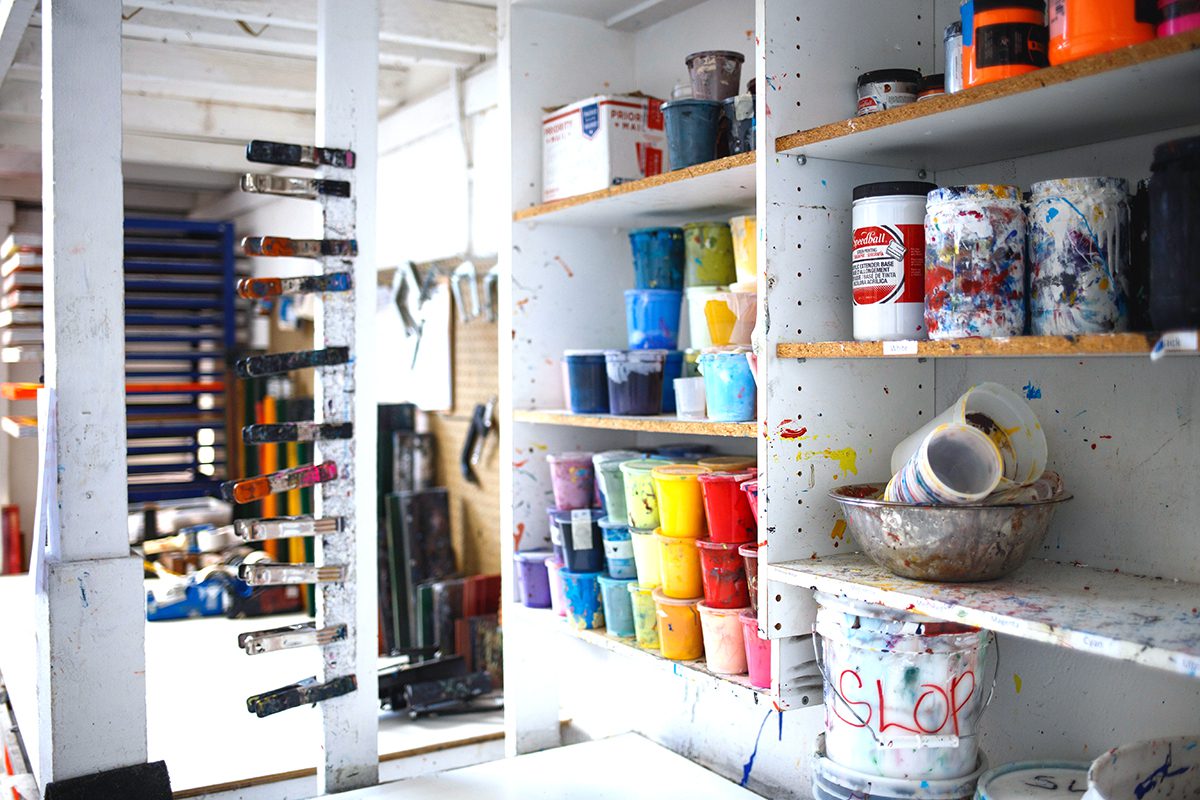Part of getting our classrooms and carts ready for the school year is assessing our stock of supplies. If your closet is anything like mine, you probably see some gaps. Many of us receive little to no funding from our schools and districts, yet we are responsible for providing students with supplies.
One of the most challenging and ongoing parts of being an art teacher is getting donations. A way to ensure donations year after year is to build connections with community members. Involving your community in your art classroom builds your program’s reputation. This involvement shows the students the people in the community who value the students’ artwork.
So how do you get started?

Design a Flyer for Your Program.
First things first, design a flyer for your program. Include the name of your school, information about your program, and a way to contact you or the school. If your program or art teachers have an online gallery, website, or Instagram handle, add those as well. Insert images that showcase all levels of student work. As you do so, make sure you follow your district’s guidelines for sharing student work. Make sure this flyer is both printable and shareable on social media. Treat it like a business card for your program. Whenever you ask for a donation, make sure that you include either a printed or digital copy of your flyer. Send your digital flyer to your office manager. Ask them to include it with any relevant communication about the art program throughout the year.
Read on for six ways to work with your community to get monetary and supply donations for your classroom.
1. Use an Online Gallery With a Fundraising Option.
Community starts with your students and their families. Set up an online gallery that allows families to both view student artwork and buy keepsakes. It takes a little work on your end to set everything up, but most student gallery sites market their own fundraisers. This makes an online gallery a low-effort, high-reward donation option at all levels.
We have a handy guide you can peruse to determine which option is the best for your program!
2. Capitalize on Back to School Night.
Families who come to Back to School Night are also the families who are involved in their student’s learning. Take this time to introduce them to your program’s online art gallery and get them set up on the website. This is also an opportunity to thank them for previous donations and ask for materials that will be reused in the art room throughout the year.
Try an art wish list as a way to ask for material donations.

3. Ask “The Usual Suspects.”
Every community has businesses that love to host fundraisers for schools. Why not connect your art program to those businesses? Research their typical fundraising style. Do they donate a percentage of each order? Do customers need to bring a flyer or mention your program? Have the president of your art club reach out and coordinate a day for your fundraiser.
Are you still feeling stuck? Ask your school fundraising extraordinaire, like the leadership teacher or PTA president, for recommendations.
4. Expand Your Art Show.
If you host an art show, use it as an opportunity to involve your community. Ask the other elective teachers if they would like to help and take part. Could your school’s jazz band perform? Could the culinary program sell hors d’oeuvres? The more students involved, the more families will show up to support. This also leads to more exposure for your program and your hardworking students. You can even ask your students to help you brainstorm a list of local groups to approach. A store may want to provide decorations, or a restaurant could donate baked goods.
Do you want to take community involvement in your art show to the next level? Check out how to host a mini-marketplace at your school.
5. Ask for Specific Reusable Donations.
Reusing materials in artmaking creates limitations, which pushes your students creatively. Come up with a specific way to reuse materials and then ask for donations from your community. It is always a good idea to give shout-outs to individuals and organizations who donated materials to your students. By reusing materials, students become more conscious of the impact of waste and how to problem-solve an innovative solution.

Here are some examples of how to reuse materials:
- Need styrofoam for your printmaking project? Ask local restaurants for unused to-go containers.
- Need wood to anchor armatures? Ask local contractors for their offcuts or your local hardware store for scraps.
- Need plastic screw-top containers to hold slip? Ask families to hang onto their clean gelato containers or baby food jars.
- Need collage materials? Ask doctors’ offices for their old magazines, fabric stores for last year’s samples, or your local hardware store for last season’s paint chips.
Are you not sure how to ask for donations? Here is a complimentary template from our Routines for Managing Supplies PRO Pack to use as a starting point.

6. Host a Gallery Night Fundraiser at a Local Business.
Brainstorm with your students to find a place off-campus to display their artwork. It would be a bonus to work with a business owned by a student’s family! Ask the owner if they would be willing to host a gallery night fundraiser. Make sure you agree on a date and time and how the work will be displayed and taken down. Then promote the event! Your students will be excited to see their work publicly displayed. Friends and family will come out to support them. The owner will also appreciate the uptick in traffic and business on the night of the fundraiser.
For more tips on getting started, read this handy article about displaying student art in community spaces.
Share Your Gratitude.
Remember that flyer you made earlier? With a quick edit, you can have it say, “Proud supporter of our school’s art program!” for contributors to post in their establishment. You can also share a digital copy of the new version, so they can share it on their social media platforms or website. Include a note of thanks from the students with that flyer. If you have a website for your program, be sure to share a list of community donors and supporters. If you have an art show for your program, post that list there as well. This will help community members feel appreciated and noticed. They will also be more likely to continue supporting your program in the future.
Students’ lives do not begin and end at school. It is important to show that their community cares about their creativity. By involving the community through donations, students learn that they are valued out in the world as well as in your room. You, as the teacher, learn more about your students through their close relationships and connections. You also have the opportunity to create local long-term partnerships that will support and advocate for your program. If you are interested in hearing more about fundraising, check out the Fundraising at the Secondary Level PRO Pack!
What are three ways you will involve the community in your art program this year?
What are four “reuse” supplies you can ask your community for?
Magazine articles and podcasts are opinions of professional education contributors and do not necessarily represent the position of the Art of Education University (AOEU) or its academic offerings. Contributors use terms in the way they are most often talked about in the scope of their educational experiences.





